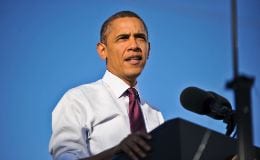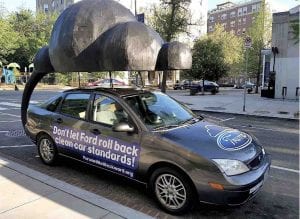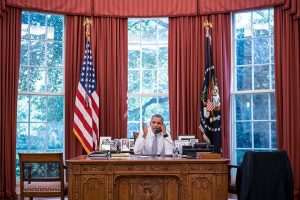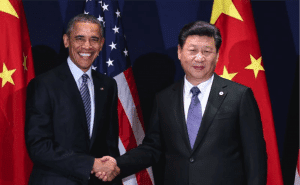Just as Tony Abbott reminded Australians on Monday that his idea of governing in 2015 revolves around building more roads and staunchly ignoring climate change, the President of the United States, Barack Obama, reminded us that most of the rest of the world is on a completely different track.
Like Abbott’s career-defining speech at the National Press Club in Canberra, Obama’s FY2016 budget proposal had a clear focus on improving infrastructure and quality of life for his constituents.
But while Abbott’s idea of future-proofing Australia is to axe its working carbon tax and, well, build more roads, Obama’s policy vision involves equipping his country with the infrastructure and other tools necessary to adjust to a rapidly changing climate and the global shift to a low-carbon economy.

As Reuters reports, Obama’s proposal for the fiscal 2016 budget, unveiled on Monday, includes boosting government funding for clean energy by 7 per cent and a new $4 billion fund to encourage states to make faster and deeper cuts to emissions from power plants.
The proposed $4 billion fund would be available to any state that applies, Janet McCabe, acting assistant Environmental Protection Agency Administrator in charge of air regulations, told reporters.
“What we will be looking for are states that will get (carbon emission) reductions earlier… or seek to go further than final guidelines require,” she said.
States would have access to money to put towards such measures as funding clean energy technologies, funding for low-income communities and incentives for businesses to back projects that cut down on emissions.
In a section titled “Improving Incentives for Research and Clean Energy”, the Obama administration also proposes permanent extension of tax credits that support solar and wind turbine installation.
As Deutsche Bank explains, currently in the US, the solar Investment Tax Credit is structured as a tax credit towards 30 per cent of the fair market value of an installed solar array.
Deutsche analysts describe it as “a significant positive” for the US solar sector, signalling strong support for renewables despite the current low oil price environment.
“Whether or not the ITC gets extended beyond 2016 still remains to be seen, but we believe this proposal certainly increases the chances of some sort of a positive outcome compared to the current step down of ITC to 10% beyond the 2016 timeframe,” Deutsche analyst Vishal Shah said in a note on Tuesday.
Shah says one of the possible outcomes is the grandfathering of all projects that start before the end of 2016 timeframe – as under current law, all projects have to be completed before end-2016 to get the 30 per cent ITC.
Another potential scenario, he says, is a much more gradual step-down of the ITC from 30 per cent to 10 per cent over multiple years.
“Either scenario would be a positive for overall industry fundamentals and investor sentiment, in our view,” Shah writes.
Elsewhere in the budget, there is a $500 million request for the Green Climate Fund to provide critically-needed capital that helps poor countries deal with climate disruption.
Interestingly, Obama’s budget plan also gives a nod to the decline of coal, with the addition of measures to help America’s no-longer dominant coal industry adjust.
The plan, called POWER Plus, provides more than $55 million in funding for job training, job creation, economic diversification, and other economic efforts in communities that have experienced layoffs due to the declining coal industry, reports Climate Progress.
According to the White House, that funding is “unprecedented” and will go toward improving the economic security of coal miners and their families, who have “helped keep the lights on in this nation for generations.”
The plan includes funding for environmental recovery, too, with $5 million to be provided to the Environmental Protection Agency’s Brownfields Program, which works to rehabilitate land contaminated by pollution, and toward property affected by a recently-shuttered coal plant.
“Our point here is that while policymakers can disagree about the reasons why the coal industry is struggling, all Americans should be able to agree that these workers and communities, who are in some of the most economically distressed parts of the country, deserve help from the federal government,” Jason Walsh, a senior White House policy adviser told the Charleston Gazette.
Naturally, America’s environmental groups approve.
“Budgets are the truest reflection of government priorities and with today’s budget President Obama makes clear that dealing with our pending climate crisis is a priority for his administration,” said
Friends of the Earth President Erich Pica in a statement.
“The president has already taken significant steps to deal with climate change, and by proposing $4 billion to help states go beyond his Clean Power Plan, he acknowledges that much more is needed.
“Indeed, we must address the coming climate catastrophes and shore up our resilience. That means taking bold actions to move our country toward a future fueled by 100 percent renewable energy.”
Meanwhile, in another example that mainstream America “gets it” on clean technology and where the future’s headed, here’s one of the ads featured during Sunday’s Super Bowl game. Spoiler: it’s about an electric car.










